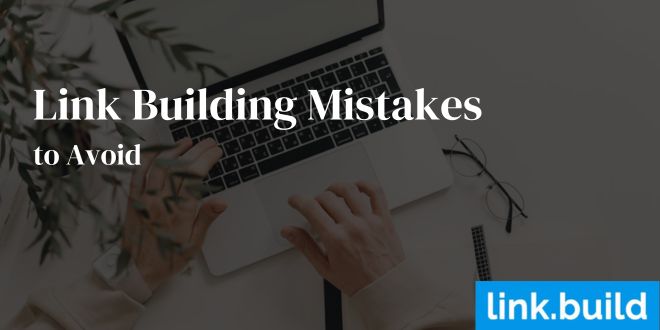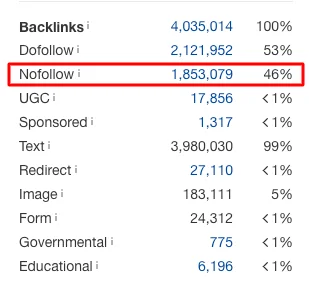10 Link Building Mistakes to Avoid

While link building remains critical for SEO success, many newbie link building mistakes may continue to hamper your website's ability to successfully dominate your niche online.
While some links can supercharge your SEO, others can act as an online marketing death sentence.
The biggest issue we typically see when it comes to mistakes made in SEO link building is when users build their links in a proverbial vacuum.
That is, they build links to the exclusion of other Google ranking factors and search engine optimization best practices.
Or gal, as the case may be.
Here are our ten most common link building mistakes to avoid. Enjoy!
Ignoring Anchor Text Best Practices
Anchor text includes both the text in the link and the title of the link.
Both of these provide signals to the search engine crawlers as to what the linked-to page is all about, but you can overdo your anchor text when it comes to link building.
For example:

What constitutes a "natural" amount of exact-match anchors differs between page type and industry?
An exact match anchor text weight of 20% may be perfectly natural in one niche but patently harmful in another.
The weight anchor text you use matters, but only in relation to the sites that outrank you.
That's why keyword research is so important.
You may find that you need more exact match anchors, not less, in order to outrank a competitor for a given term, but you won't know until you dig in.
Pro tip: when performing anchor text keyword research on yourself and your competition, it will be important to note instances of link syndication that may have appeared to have had a large impact on an outlandish anchor text weight percentage, but in reality is only counted once by search engines for ranking purposes. This can be a lurking variable if you are analyzing links in Moz or Ahrefs.
Ignoring Relevance and User Intent
When your linked-to content is not relevant to the context of the article that is placed on another website, you run the risk of the following:
- Referral traffic bounces and/or low dwell times
- RankBrain content deindexing
- Poor user experience
In each case, search engines can see through the poor metrics and will discount the rankings of your page accordingly (relative to competitors).
Remember, backlink relevance is tied very closely to user intent and ignoring both of these factors means you're really focused on building links for search engines and not for people.
Fortunately for white hat SEO specialists, those days are long over.
Relevance means that if you're on a site that talks about dog treats or home maintenance, you're not linking to a site that talks about payday loans in a totally unnatural context.
In addition, it can also mean that you're typically linking to content that promotes or adds value to the post, not just inserting a link that has no relevance.
Ignoring Referrals & Click-Throughs
Backlinks are not just about SEO and rankings in SERPs.
Quality, relevant sites with relevant traffic can create more click-through opportunities than direct search engine rankings, by far.
Truly applicable click-throughs and referral traffic have a much higher resulting impact on potential leads and sales.
Quality content engenders a higher quality of readership, which may prove more in line with your target audience.
You should also not avoid the possibility of referrals and click-throughs as a side benefit to your link building.
Ignoring their potential is foolhardy, but basing your strategy on them is equally dumb.
This leads me to my next point...
Getting Hung Up on Avoiding Rel="Nofollow" Links
A natural backlink profile should have a good number of rel= "nofollow," re= "sponsored" and rel= "ugc" links associated with the domain:

It looks more unnatural to have ALL dofollow backlinks coming to your website.
As such, if you're thinking of hiring a link building service but, in the next breath, tell them you don't want ANY nofollow links in your campaigns, no one wins.
Your website gets lopsided on its linkgraph or link profile; the SEO company is not going to be delivering long-term sustainable results, and, worse yet, your website is less likely to rank.
We suggest performing the following research when it comes to how many nofollow vs. dofollow links should be on your website:
- Do backlink research and a complete backlink analysis on your top 20 competitors
- Find the average percentages of total nofollow links to your biggest competitors.
- Use that as your gauge as to what share of your overall links should be coming in as nofollow, sponsored, or UGC (user generated content) tags.
Keep in mind that in some cases, syndicated content that is nofollow or dofollow links can have an even more rapid impact and change on the share of total links that are nofollow vs. dofollow.
Using PBNs and Link Farms
A Private Blog Network (PBN) is a network of websites used to build links back to a target website in order to manipulate its search engine rankings.
Similarly, link farms are groups of websites that all hyperlink to every other site in the group, typically with excessive reciprocal linking, with the intention of increasing each linked page's search engine ranking.
Both PBNs and link farms violate Google's guidelines and should be avoided if you're linking to build links in a white hat way.
It's extremely tempting to utilize these short-sighted tactics with low-quality sites to achieve short-term wins, but the likelihood of your tactics getting sniffed out and snubbed in the next round of perpetual Google updates is very high.
Stay on the safe side.
Friends don't let friends use PBNs or excessive reciprocal links.
Creating Low-Quality or Automated Content
Creating low-quality content is bad for SEO because it's bad for users. Period.
Low-quality content typically lacks the necessary detail and accuracy required to establish relevance and authority with online readers, as well as search engines.
Additionally, low-quality content can often contain incorrect information and can be filled with grammar and spelling mistakes, making it difficult for readers to understand.
Difficult flow can then lead to high bounce rates, as readers do not trust the content and quickly leave the website.
Search engines (like Google and Bing) also take into account user experience when ranking content and a website that provides low-quality content is likely to be penalized in search engine rankings.
If a website consistently posts low-quality content, it could even be blacklisted by the search engine, which could result in a significant (or total) loss of potential website visitors.
Creating high-quality content is key to SEO success as it helps build trust and authority with readers, as well as search engines.
High-quality content should be engaging, informative, accurate, organized, and easy to read.
Quality content also includes relevant statistics that are factually accurate and backed by research.
That was the ultimate reason and understanding of the first search engine algorithms.
And just because content looks quality, if it was created automagically by GPT or Jasper.ai or Copy.ai, user beware!
Google and other search engines are getting better and better at detecting what types of content are poor quality and even detecting what content may have been created by GPT technology.
If HuggingFace can produce its own GPT detector tool, you can assume Google is doing the same so as to effectively determine what content is real and what content was created by a bot.
Yes, there are patterns!
Focusing on Domain Authority (DA) or Domain Rating (DR) to the Exclusion of All Else
Clients rightfully want to increase their domain authority or domain rating in order to boost their rankings online.
However, when authority is sought to the exclusion of quality, it can prove more detrimental than helpful.
When chasing domain authority, clients may seek publisher relationships that:
- It may not be an industry fit or a fit for relevancy
- Are likely a repurposed high DA site in a PBN
Are you noticing a pattern in these link building mistakes?
Whenever you're not diversified in how you approach your marketing strategies, you are more likely to land yourself in a scenario that reeks of manipulation.
Focusing on Quantity, Not Quality
We have advocated before for building fewer backlinks, not more.
Total referring domains is certainly a positive ranking signal that correlates directly with search traffic:

However, too many links without a proper focus on quality are both foolish and reckless.
Spammy link building tactics are dying a quick death, especially with the release of algorithm updates like SpamBrain.
While a good number of low domain authority sites are part of a proper link building strategy, a single link from a quality, relevant site is more likely to have a greater impact on your SEO than hundreds of low quality links from spammy, generic article sites.
Focus on quality first; quantity will come with time as you reach the tipping point in link building.
Ignoring Link Velocity Principles
Link velocity refers to the rate at which a website accumulates links over time.
It is a measure of the rate at which new external links are added to a site, and plays an important role in determining that site's search engine rankings.
Link velocity can be used to identify if a website is engaging in link building efforts that are against the guidelines of search engines (many of which we have already discussed above).
Would it make sense if your website went from having 50 new links per month to 500? What about from 100 to 10,000?
In the absence of virality, which typically can be easily detected, quick, large-scale link acquisition plans can often backfire, resulting in algorithmic drops and even manual penalties to your website.
Artificially increasing the rate at which links are acquired is a tell-tale sign of unethical linking practices that should be avoided.
Building Links BEFORE On-page SEO is On-Point
Does it make sense that a page would naturally attract links if the content were thin, uninteresting, or not optimized?
Why would such a low-quality, uninteresting, and not-optimized website ever be worthy of a whole host of sudden inbound links?
Before you build any links to your web pages, you need to ask yourself:
- Is this page fully optimized?
- Does this page offer more, better, or more interesting value than what is already available on the web so that someone would truly want to link to it (and not just because I paid them for a link)?
If you want your hard-earned link building budget to be spent wisely, you first need to get your on-site house in order.
Only then should you think about building links to your website.
Don't Make Link Building Mistakes. Make Link Building Success!
Are you personally tired of making mistakes in your link building that keep taking your rankings down?
Are you tired of seeing your hard-earned efforts of building links get negated by the latest Google algorithm update?
Let our expert link building company help you avoid the common link building mistakes that are currently so rampant in SEO.
Contact us today to discuss your strategies with a member of our link building team.


.svg)

.jpg)
.jpg)
.jpg)